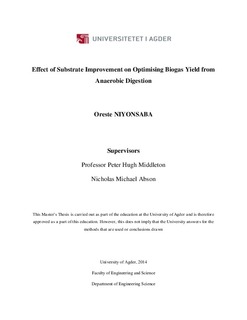| dc.description.abstract | The anaerobic digestion process involves the decomposition of the organic matter to yield biogas; gas that is mainly composed of methane and carbon dioxide with traces of some other gases. This process is used for different purposes including municipal waste treatment, wastewater treatment, fertilizer production, and farm wastes disposal as well as energy production. It is accomplished in three main stages; hydrolysis, acidogenesis and methanogenesis with each of the stages achieved by specific microorganisms that are active in limited ranges of operational and environmental conditions. These conditions are controlled to achieve an optimal output of the process. For example for the energy production purposes, the energy output needs to be optimised in terms of operating conditions. To produce an optimal amount of biogas from a certain substrate, the latter should be analysed for its nutritional composition and if some of the nutrients are not in appropriate amounts they are adjusted by mixing more than one type of substrates. The purpose of this study is to investigate the effect of improving substrate nutritional composition on the optimal yield of the anaerobic digestion process. In other words, we are looking at a way to increasing the biogas yield by improving the qualitative composition of the substrates. To achieve this objective, a thorough literature review was done to be aware of the effect of various environmental and operational parameters on the yield of the anaerobic digestion. These parameters include the temperature, the pH of the substrates, the carbon to nitrogen ratio, total solids content and substrates composition. To study the effect of the latter, we carried out an inventory of the mostly used substrates for the production of biogas. These include agricultural residues, animal manures, municipal solid wastes and food wastes. Food wastes collected from the kitchen and exclusively fruit wastes were digested at 55±2o C and at 37±2o C. Digestion of food wastes characterised by a total solids content of 10.423 % and volatile solids to total solids content of 89.145 % produced 95mL/g VS of biogas at thermophilic temperature, fruit wastes with a total solids content of 8.253 % and volatile solids to total solids content of 91.495 % produced 30mL/g VS. Mixed together making total solids content of 12.493 % and volatile solids to total solids content ratio of 86.988 % food and fruit wastes produced 110mL/g VS. Results of this study show that mixing food wastes with fruit wastes improved the biogas yield by 13.67 %. The same increase was observable at mesophilic temperature. This increase in biogas yield in this study shows that optimal biogas yield is produced by improving the nutritional composition of substrates. Keywords: Anaerobic Digestion, Biogas Yield, Substrates, Food wastes, Fruit wastes, Characterisation. | nb_NO |
